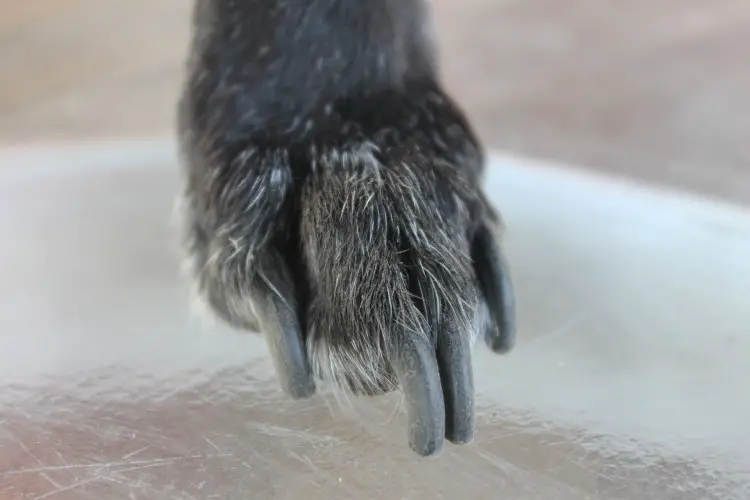How to Cut an Uncooperative Dogs Nails Without a Fight
A big reason why so many dogs do not like to have their nails trimmed is not that they don’t want their nails trimmed but rather because they simply do not like to have their paws touched and handled.
Although very rough and able to handle all kinds of terrain, a dog’s paws are also quite sensitive.
Dogs that are not used to having their paws touched may dislike it because they are not used to the sensation and may even feel as if they are somewhat vulnerable.
It is best to trim nails regularly from an early age to get them accustomed to having them handled.
Teaching a dog to “shake a paw” is a great way to get them used to have their paws handled and will make trimming their nails more enjoyable for both owner and dog.
It will be more relaxing for a dog during a nail trim if they are reassured and praised throughout the process.
It is also a great idea to reward a pooch with its favorite treat, so they associate a nail trimming session with a reward and may even look forward to it.
It also helps to stay calm and to avoid being nervous or anxious since dogs can pick up on their owner’s emotions.
Why Every Dog Needs Their Nails Trimmed
Many dog owners struggle to get their canines groomed, whether it be a haircut, bath, or the dreaded nail trimming appointment.
Having trimmed nails is not just for looks, but it is also important for keeping a dog nice and healthy.
Since most dogs’ nails do not get worn down enough on their own, they will continue to grow. In very severe cases, they will even grow until they become embedded in the pads of their paws.
If they get snagged on something or break off, splinter, or crack, causing a lot of discomforts and even arthritis and infection.
Dogs with long nails also cause that clicking sound whenever they walk on hard surfaces and can also make it uncomfortable to stand on their paws.

There’s More Than One Way to Trim a Dog’s Nails
Although it’s good for them, many dogs will put up a bit of a fight when they are getting their nails trimmed.
Trimming their nails can be very challenging if they are a large breed, and it can be dangerous since they need to be still during the trimming process to avoid getting nicked.
There are a few different ways to trim a dog’s nails. There are many different designs of dog nail clippers to choose from, and most pet stores will carry them.
It doesn’t really matter what kind of nail clippers are used but they need to be the right size for the dog. The package should specify whether they are intended for a small, medium, or large dog breed.
If a dog doesn’t like having its nails trimmed, a nail grinder may be a better option since it is more difficult to accidentally take off too much of the nail if the dog moves abruptly.
The downside to this nail trimmer design is that it takes longer to trim nails down, especially if they are very long. But there is less risk of accidentally trimming nails too short or nicking a paw.
A nail grinder also makes it possible to round off the edges, preventing them from getting snagged right after they are cut and blunter.
I personally use this grinder to manage my dog’s nails. I can highly recommend it because it didn’t take long for my dogs to get used to it.
Trim to the Quick Slowly
Dogs’ nails are quite different from human nails. For one, they are not flat but are instead rounded and much thicker.
They are also sometimes black, which makes it more difficult to know where to trim the nail without hurting them.
If trimming a dog’s nails for the first time, it can be somewhat nerve-racking to know where to cut, but there are a couple of fail-safe ways always to know where to trim. Dogs’ nails have what is called a nail quick.
A nail quick is another word for nerves and blood vessels. Obviously, you want to avoid cutting into the nail quick, or it could hurt the poor pooch.
To find where the nail quick is, an examination of the nail from the side should reveal a pinkish shadow or a black spot past the nail pulp in dark-colored nails.
It is best to trim about one millimeter at a time because the center of the nail will be slightly pink right before the quick begins.
If trimmed enough to expose this pink area of the nail, it is time to stop. If it is white and flakey, it needs to be trimmed more.
If a dog’s nails are black, it is much harder to detect where the quick will be, but not impossible.
Since the quick will not be visible from the side as they would be if they were white nails, it is best to look at the nail’s shape.
If there is a curve or hook, it is safe to trim it off so that it is flat across the bottom.
If there is no hook, but the nails are still long, it is necessary to trim about a millimeter at a time until the cut edge reveals pink.
As the nail is cut down, it should change from a white or gray center to black and then pink right before the quick.
